

The Romantics. A Brief Guide to Romanticism. “In spite of difference of soil and climate, of language and manners, of laws and customs, in spite of things silently gone out of mind and things violently destroyed, the Poet binds together by passion and knowledge the vast empire of human society, as it is spread over the whole earth, and over all time.

The objects of the Poet’s thoughts are everywhere; though the eyes and senses of man are, it is true, his favorite guides, yet he will follow wheresoever he can find an atmosphere of sensation in which to move his wings. Romancticism - Literature Periods & Movements. Literature Network » Literary Periods » Romancticism.
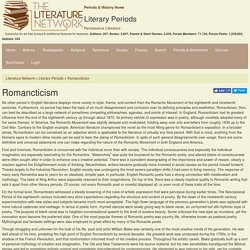
English literature - The Romantic period. Notes on the Romantic Age. The Romantic Age Important themes The Romantic Movement of the early 19th was a reaction to many cultural, social and political developments.

Many artists and thinkers began to see developments in society threatening individualism: the factory system made human beings replaceable parts in a system, and mass political movements (like the French Revolution) diminished individual accomplishment. Similarly, increased urbanization made people feel cut off nature. Also, Neoclassicism's strict rules and formalism began to seem limiting. In reaction, the Romantic Movement stressed the individuality of the artist's expression, a personal relationship with nature, and a trust in emotion and subjective experience.
Important philosophical figures: Immanuel Kant (1724-1804): Kant is not a Romantic philosopher, but his ideas, especially his Pure Critique of Reason, influenced many Romantic thinkers. Romanticism. If the Enlightenment was a movement which started among a tiny elite and slowly spread to make its influence felt throughout society, Romanticism was more widespread both in its origins and influence.
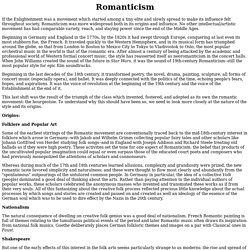
No other intellectual/artistic movement has had comparable variety, reach, and staying power since the end of the Middle Ages. Beginning in Germany and England in the 1770s, by the 1820s it had swept through Europe, conquering at last even its most stubborn foe, the French. It traveled quickly to the Western Hemisphere, and in its musical form has triumphed around the globe, so that from London to Boston to Mexico City to Tokyo to Vladivostok to Oslo, the most popular orchestral music in the world is that of the romantic era.
After almost a century of being attacked by the academic and professional world of Western formal concert music, the style has reasserted itself as neoromanticism in the concert halls. Origins: Folklore and Popular Art Nationalism. Info:Private Page. The Culture of Rebellion in the Romantic Era. Eugene Delacroix, Liberty Leading the People, 1830.

One of Delacroix’s best known works, the painting depicts a bare-breasted Liberty leading Parisians of mixed social and economic backgrounds into battle. Lecture 16: The Romantic Era. The categories which it has become customary to use in distinguishing and classifying "movements" in literature or philosophy and in describing the nature of the significant transitions which have taken place in taste and in opinion, are far too rough, crude, undiscriminating -- and none of them so hopelessly as the category "Romantic.
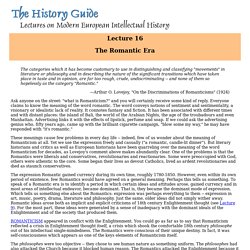
" ---Arthur O. Lovejoy, "On the Discriminations of Romanticisms" (1924) Ask anyone on the street: "what is Romanticism? " and you will certainly receive some kind of reply. The Norton Anthology of English Literature, Ninth Edition: W. W. Norton StudySpace. Volume D The Romantic Period 1785–1832 (NAEL Vol.
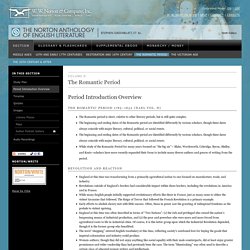
D) The Romantic period is short, relative to other literary periods, but is still quite complex. Christianity. Reformation, Britannica Classic: The Reformation: Age of RevoltEncyclopædia Britannica, Inc.the religious revolution that took place in the Western church in the 16th century.
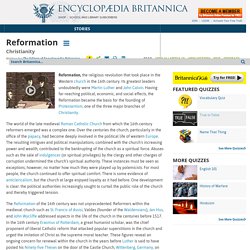
Its greatest leaders undoubtedly were Martin Luther and John Calvin. Johannes Gutenberg - Inventor. German inventor Johannes Gutenberg developed a method of movable type and used it to create one of the Western world's first major printed books, the “Forty-Two-Line” Bible.
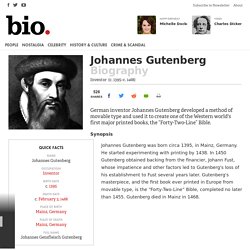
Synopsis Johannes Gutenberg was born circa 1395, in Mainz, Germany. He started experimenting with printing by 1438. In 1450 Gutenberg obtained backing from the financier, Johann Fust, whose impatience and other factors led to Gutenberg's loss of his establishment to Fust several years later. Gutenberg's masterpiece, and the first book ever printed in Europe from movable type, is the “Forty-Two-Line” Bible, completed no later than 1455. Early Life Born into a modest merchant family in Mainz, Germany, circa 1395, Johannes Gutenberg’s work as an inventor and printer would have a major impact on communication and learning worldwide.
Experiments in Printing Financial Trouble In 1448, Johannes Gutenberg moved back to Mainz and by 1450 was operating a print shop. Later Life Related Videos. The Reformation - Facts & Summary. History: Renaissance for Kids. Back to History for Kids The Renaissance was a period of time from the 14th to the 17th century in Europe.

This era bridged the time between the Middle Ages and modern times. The word "Renaissance" means "rebirth". European history. Renaissance Art - Facts & Summary.